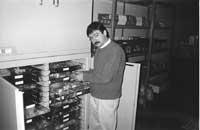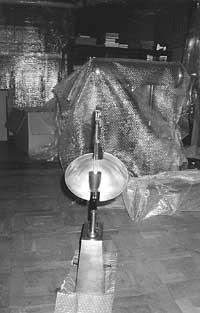Royal Seminary of Bergara

In 1593 the Jesuits founded a school in this beautiful building of Saint Martin de Agirre Square in Bergara; the first school founded by the Jesuits in Gipuzkoa was in Oñati, but because they had to close it, they came to Bergara. Initially the classes were taught in private homes, until the completion of the definitive building.
XVII. In the middle of the 20th century the old church was demolished and the new one was built, with a special style of the Jesuits. The Jesuits founded in their adjoining house the “First Letters” (basic education) and the “School of Humanities” (secondary education).
In 1767 Charles III expelled the Jesuits from the kingdom and the building was empty. At that time, on the other hand, the Real Sociedad Vascongada de Amigos del País had just been founded and, after long negotiations, managed to take over the house. Their main objective was to create in it a powerful educational center, which they called: Royal Basque Patriotic Seminar. It is at this time that the most famous and glorious stage of the building begins. One of the objectives of the RSVAPS was to promote little extended technical areas of knowledge: Mineralogy, Physics and Chemistry. At this time the first steps of modern chemistry were being taken, as scientists began to overcome alchemy. In Paris there was a very important movement in this regard and the scientists here took care to bring all these novelties here. Likewise, the most prestigious physicists and chemists in Paris and other parts of Europe were “signed” and went to teach and research (Proust, Chabaneau and Tumborg, among others). As mentioned above, the Elhuyar brothers were also here as professors and researchers.
One of them was the discovery of the name and prestige of the Elhuyar brothers worldwide: the isolation of wolfram.
Under the Effects of Wars

In 1794, on the occasion of the War of the Convention, the French army arrived and all the programs of studies were interrupted. Since then it has been a difficult task to regain the strength of that time. XIX. In the eighteenth century there were great historical changes that gave name to the educational center. In the first Carlist War it also functioned as a hospital. In 1840 the repair work was retaken in order to recover the educational center; the laboratory reconstruction equipment was purchased with profusion (especially in Paris).
The Real Seminario is the first institute we had in Gipuzkoa and the only one of the times. During the Second Carlist War the doors of the Seminary were closed again and the institute moved to San Sebastian. In 1880 the house was left in the hands of the Dominicans, where a secondary school with important collections was installed.
Until 1975 they were the Dominicans and that year the building was divided into two parts. In the background is the ikastola of Bergara and in front of the UNED. In some rooms the devices could be seen everywhere, but not being under the responsibility of anyone were all lost. Some Berbers managed to organize a permanent exhibition with the material they had in the mid-1980s. But the exhibition was not for the continuous visits, it gradually lost.
Recovering efforts in recent years
In 1992 the City Council convened a work place for the Museum, being available to Xabier Aramburu. The main objective was to manage the existing collection at that time, but Aramburu could not manage anything in that context as complicated as the absence of security measures, the state of unfortunate conservation, the metal pieces erdoilized by moisture, the animals dissected, damaged or broken by fungi, etc., long and regrettable.

There were no pieces, no one knew and Xabier Aramburu himself explained that he had to start with zero: “We didn’t know what we had, what time the pieces were, what importance they had... Thus, I was able to launch a quadrennial plan with the subsidy of the City of Bergara and the Diputación de Gipuzkoa”. The first objective was to ensure the continuity of the collection and the second to have a minimum knowledge of it in order to advance. They also begin to solve the humidity problems of the room, then cleaned and treated the pieces. “Today you can ensure the permanence of the collection,” says Xabier Aramburu. The collection is divided into five sections:
Scientific instruments: 250 pieces.
Zoology: 1,022 pieces.
Human anatomy: 7 pieces.
Mineralogy: 1.181 pieces.
Paleontology: 369 pieces.
Subsequently, the collection was restored and, on the other hand, the detailed investigation of the pieces. Thanks to this, we can now know the importance of the treasure that houses the Royal Seminary of Bergara: “The collection has almost 2,829 pieces of which we have analyzed 91% in these four years. Once all the pieces have been inventoried, we have them classified and now we are working with the catalogue, researching in detail each piece. We have also begun to make reforms in each of the sections,” said Aramburu.
Preparing a collection for the future

The first phase of the Plan is completed, but in accordance with the objectives set in the second phase, the collection of the exhibition to be installed in the future museum must be prepared. This plan has a term of six years and, as Aramburu has told us, a classification must be made to achieve this objective: “Of the pieces we have, some are important and others, however, are quite simple, it is not important to present them. Some of us have to renew them, but others are not going to be possible, because they are very bad. In the last year we have designed a collection that can be presented. We have chosen among the pieces we have, always knowing the real value of each piece” We have to complete some sections so that they have coherence with the theme and, therefore, have to get new pieces.
However, they know perfectly what are the pieces to be seen in the third phase, with the opening of the museum: a total of 686. According to the project, during these six years they will take the necessary steps to achieve this collection: renovate the pieces and carry out an exhaustive investigation that allows to give the appropriate explanations: the exact year, who made them, etc. In short, it is about knowing each piece thoroughly. At that moment they will be prepared to face the third phase: find the right room for the exhibition and open the museum. But the current room has less than 200 m2 and, as Aramburu told us, the museum can hardly be made there.

The reform works have advanced thanks to the sweat of many people. In the first phase a zoologist, chemist and geologist worked. He directs and coordinates Xabier Aramburu.
Most of the scientific pieces are the XIX. They are from the twentieth century, many of them acquired in Paris; it is a very important collection, since in Euskal Herria there is nothing similar. The science museums of the Basque Country present pieces of very specific fields, while the museum that will be created from the Royal Seminary of Bergara will be able to show multidisciplinary pieces. In addition, there will not be a selection of exhibitions that emerge from scratch, but the new museum of the Aitaponte will have a history of centuries.
We do not know when the new museum will open its doors; it may take many years. But when that time comes, there is no doubt that it will offer us a beautiful and interesting collection.





